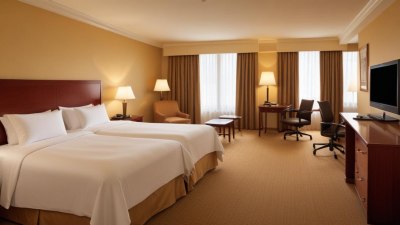Why Some Hotel Rooms Feel Like Saunas While Others Are Antarctic Research Centers
Explore the reasons why hotel room temperatures vary so drastically, from sauna-like heat to ice-cold climates.

This image was created with the assistance of Freepik
When you enter a hotel room, the experience can vary dramatically. Some rooms envelop you in warmth, making you feel like you've stepped into a sauna, while others chill you to the bone. This dramatic variation in temperature can be attributed to several factors, including hotel design, location, season, and even maintenance practices. Understanding these factors helps explain why some hotel rooms feel like Antarctic research centers while others are reminiscent of a tropical retreat.
The Impact of Location on Room Temperature
The geographical location of a hotel plays a crucial role in its heating and cooling strategy. Hotels situated in warmer climates often have rooms that feel hotter due to inadequate cooling systems, particularly during the peak summer months. If the air conditioning units are not powerful enough or if they malfunction, guests can find themselves sweating as they try to relax. Conversely, hotels in colder regions may have rooms that are overly cooled, especially if they rely heavily on evaporative cooling methods or if the central heating is insufficient. This contrast can make guests feel like they are either on a tropical getaway or stuck in an Arctic winter.
Hotel Design and Architecture
The design of a hotel also has a significant influence on how temperatures are regulated within the rooms. Hotels designed with large windows or open floor plans often lack sufficient insulation, leading to temperature variations that can feel extreme. Large glass surfaces can absorb heat during the day, especially in sunny regions, making the rooms uncomfortably warm, akin to a sauna. In contrast, buildings with thick walls and fewer windows tend to maintain a steadier, cooler climate. Traditional hotels in colder climates may still retain the proportions that keep warmth contained, offering a cozy environment. Moreover, the materials used in building and furnishing the hotel can impact how heat is managed; for instance, stone and brick constructions can retain heat longer than wooden structures.
Heating and Cooling Systems
The type and maintenance of a hotel’s heating, ventilation, and air conditioning (HVAC) systems can also contribute to the discrepancies in room temperatures. An efficient HVAC system can effectively regulate a room's temperature and humidity levels, enhancing guest comfort. In hotels where this system is outdated or poorly maintained, guests may struggle with insufficient heating or cooling. Filters may be clogged, ducts could be obstructed, or thermostats may not be calibrated correctly. In such cases, the room might become uncomfortably warm, resembling a sauna, particularly when it is hot outside, or excessively cold, like an Antarctic research center, if the heating system is compromised. Furthermore, the ability of the HVAC system to provide individualized temperature settings can significantly affect guest satisfaction; some modern hotels allow guests to control their room temperature settings through a smart device, promising a personalized experience.
Seasonal Influence and Weather Conditions
Seasonal changes play a massive role in how hotel rooms feel. During peak summer months, hotels located in warmer regions may find their air conditioning systems overworked, leading to insufficient cooling, resulting in sauna-like rooms. Conversely, wintertime can expose guests to extreme chill if the heating systems are inadequate or if windows are not properly sealed. Weather conditions such as humidity can also impact perceived temperature. For instance, high humidity can make warm rooms feel even hotter, resulting in discomfort for guests. Heating systems may struggle to manage humidity levels, leading to complaints about stifling heat during summer, particularly in tropical locations, while winter storms can bring drafts into poorly insulated rooms, making them unbearably cold.
Personal Preferences and Sensitivity
Individual preferences and sensitivity to temperature also play crucial roles in hotel room comfort. Some individuals prefer cooler environments and find warm rooms stifling, while others thrive in cozy, warm spaces reminiscent of a sauna. This personal variation can lead to mismatched expectations, resulting in discomfort regardless of actual room conditions. For instance, someone accustomed to a warmer climate might find a room chilly, while a guest from a cool region might relish the same space as pleasantly warm. Understanding a hotel's guest demographic can help in applying suitable temperature conditions within rooms, but it is impossible to please everyone. Hotels often try to strike a balance through standardization, but this can have mixed results.
Service Quality and Guest Experience
Service quality can greatly influence guests' perceptions of room temperature. A hotel known for its attentive staff will often receive higher ratings regarding comfort simply because the personnel can quickly resolve temperature issues. Conversely, a hotel with negligent service may receive negative feedback, regardless of whether the room temperature is within a reasonable range. In instances where staff can provide assistance, guests feel more comfortable reporting issues rather than suffering in silence. The interaction between staff and guests can lead to immediate solutions, such as providing extra blankets or reprogramming the air conditioning, which can greatly enhance the overall hotel experience. In contrast, a lack of engagement can lead to dissatisfaction over something as simple as room temperature.
Room Orientation and Sun Exposure
The orientation of a hotel room plays a significant role in how it absorbs and retains heat. Rooms facing south or west often receive more sunlight, especially in the afternoons and evenings, causing them to heat up. On the other hand, north-facing rooms tend to remain cooler, especially in warmer climates. This can create disparities in temperature even within the same hotel, as one side of the building may feel akin to a tropical resort while the other might evoke the atmospherics of a winter cabin. Effective blinds or blackout curtains can help mitigate direct sunlight, but not all hotels invest in quality window treatments. Guest strategies for managing temperature can include choosing rooms based on their knowledge of the building's layout, but this is often not communicated well by hotel websites or front desk staff.
Technology and Smart Rooms
In the modern era, technology has begun to play a larger role in hotel experience, including room temperature management. Some hotels are integrating smart technology to allow guests to control their room environment through apps or voice commands. For instance, guests can adjust the thermostat or ventilation with ease, leading to a more personalized experience. However, hotels without such advancements may struggle to meet the varying demands of guests regarding temperature preferences. The creation of smart rooms not only enhances comfort but also energy efficiency, helping hotels optimize their climate control systems without compromising guest satisfaction. Implementing these systems comes with a learning curve for both staff and guests, and not all hotels may be ready to provide this cutting-edge technology.
Striking a Balance
The variance in hotel room temperatures, from sauna-like heat to icy coldness, is ultimately a complex interplay of location, design, maintenance, seasonal influences, and personal preferences. While some factors can be controlled through efficient heating and cooling systems, others, such as weather conditions and orientation, can lead to varying results within the same establishment. By understanding these elements, both hotel operators and guests can better prepare and adapt to the experiences they encounter. As technology continues to advance in the hospitality industry, we may see even more tailored solutions for managing room temperatures effectively, paving the way for an improved traveler experience in the future. Nevertheless, communication regarding expectations and accommodations for temperature comfort will remain essential in achieving guest satisfaction, ensuring that no one feels stuck between the extremes of sauna-like heat and polar cold.











